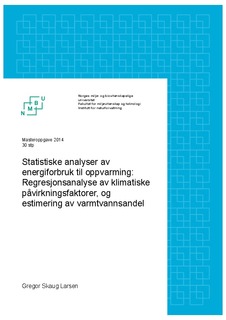| dc.contributor.author | Larsen, Gregor Skaug | |
| dc.date.accessioned | 2015-02-25T09:52:38Z | |
| dc.date.available | 2015-02-25T09:52:38Z | |
| dc.date.copyright | 2014 | |
| dc.date.issued | 2015-02-25 | |
| dc.identifier.uri | http://hdl.handle.net/11250/277689 | |
| dc.description.abstract | The following master thesis presents a statistical analysis of energy delivered through district heating for a selection of buildings in Oslo, Norway. The research objective is to study whether meteorological factors (i.e. wind speed, air pressure, solar radiation) can be used as supplement to outdoor temperature to explain the energy consumption. In addition simple linear regression has evaluated as a method to estimate the percentage of heating energy spent on hot water.
The meteorological variables used in the analysis have been found in the Norwegian Meteorological Institutes online database – “eKlima”, and are registered at Blindern survey station in Oslo. The data on energy consumption has been collected by Kristensen for his master thesis at The Norwegian University of Life Sciences spring 2014 (Kristensen 2014).
In the analysis procedure it has been decided to split the observed energy consumptions in three populations – residential, commercial, and a total population. The latter population consisted of the sum of energy spent in the residential and the commercial populations. The reason for this grouping of the populations was due to the assumption that commercial energy consumption has a different characteristic than residential energy consumption and it would be interesting to see whether potential meteorological explanatory variables would be valid for all populations.
The study has proven that the expected energy consumption of all populations varies according to which direction the wind blows. It can be expected higher energy consumption with wind from north and east than wind from the south and west. This correlates to higher expected wind speed and lower expected outdoor temperature with wind blowing from north and east, and lower expected wind speed and higher expected outdoor temperature with wind from the south and west. The study concludes that the convection heat loss is affected by from which direction the wind blows.
By multivariate linear regression is has been found that the climatic factors, average wind speed, number of hours with sunshine, average air pressure, and average energy degrees (difference between average outdoor temperature and 17 °C indoor temperature), are statistically significant as explanatory variables for the energy consumption in all populations. The study concludes that these climatic variables better explain the energy consumption of the residential population than simple linear regression with energy degrees alone as explanatory variables does.
It has been found that simple linear regression can be used as a method to estimate the percentage of heat energy used for hot water in the residential population. Still it is a weakness to the method as it in this study assumes that the energy spent on heating water is constant during the observation period. This method weakness can be somewhat counter acted by analysing the energy consumption year by year.
The energy consumption of the commercial population has been proven non-linear correlated with energy degrees. Cubic estimation of the commercial energy consumption has proven to have a higher coefficient of determination than estimation by linear regression. By assumption of valid cubic correlation the energy consumption of the commercial population has been proven to have different outdoor temperature sensitivity than the residential population. The thesis concludes that a non-linear correlation and temperature sensitivity needs further study. | nb_NO |
| dc.language.iso | nob | nb_NO |
| dc.publisher | Norwegian University of Life Sciences, Ås | |
| dc.rights | Navngivelse 3.0 Norge | * |
| dc.rights | Navngivelse-Ikkekommersiell-IngenBearbeidelse 3.0 Norge | * |
| dc.rights.uri | http://creativecommons.org/licenses/by-nc-nd/3.0/no/ | * |
| dc.subject | energiforbruk | nb_NO |
| dc.subject | oppvarming | nb_NO |
| dc.subject | variable | nb_NO |
| dc.subject | regresjon | nb_NO |
| dc.subject | forklart varians | nb_NO |
| dc.subject | varmtvann | nb_NO |
| dc.title | Statistiske analyser av energiforbruk til oppvarming: Regresjonsanalyse av klimatiske påvirkningsfaktorer, og estimering av varmtvannsandel | nb_NO |
| dc.title.alternative | Statistical Analysis of Energy Consumption for Heating: Regression Analysis of Climatic Influences, and Estimation of Hot Water Consumption | nb_NO |
| dc.type | Master thesis | nb_NO |
| dc.subject.nsi | VDP::Mathematics and natural science: 400::Mathematics: 410::Statistics: 412 | nb_NO |
| dc.subject.nsi | VDP::Technology: 500::Environmental engineering: 610 | nb_NO |
| dc.subject.nsi | VDP::Technology: 500::Mechanical engineering: 570::Machinery energy and environmental technology: 573 | nb_NO |
| dc.source.pagenumber | 102 | nb_NO |
| dc.description.localcode | M-FORNY | nb_NO |

